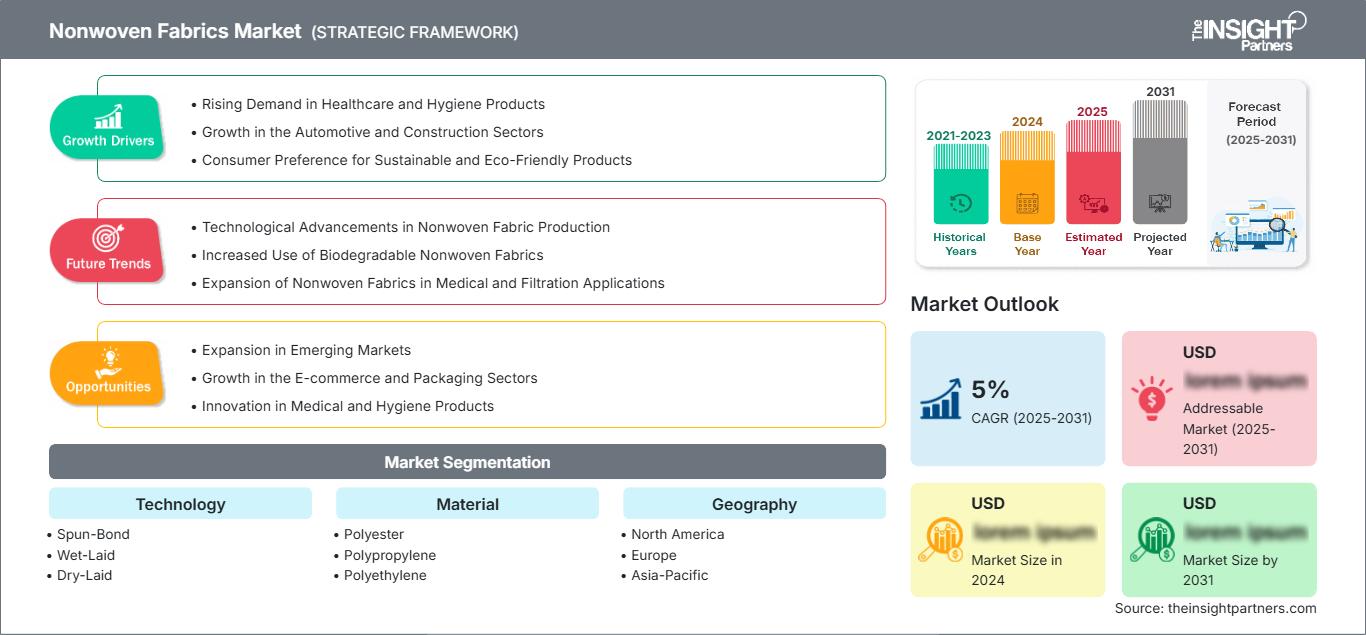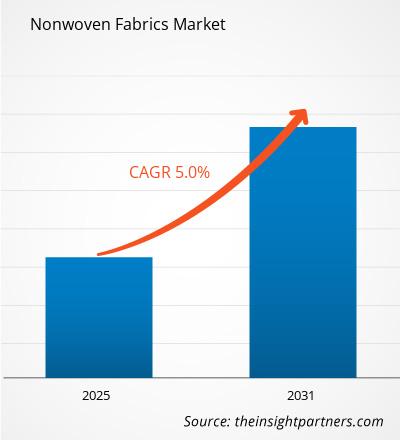Si prevede che il mercato dei tessuti non tessuti registrerà un CAGR del 5% dal 2025 al 2031, con una dimensione del mercato in espansione da XX milioni di dollari nel 2024 a XX milioni di dollari entro il 2031.
Dimensioni e previsioni del mercato dei tessuti non tessuti (2021-2031), analisi delle opportunità di crescita globali e regionali, tecnologia (spun-bond, wet-laid, dry-laid e altre tecnologie), materiale (poliestere, polipropilene, polietilene, rayon e altri materiali), settore di utilizzo finale (edilizia, tessile, sanità, automotive e altri settori di utilizzo finale) e area geografica (Nord America, Europa, Asia-Pacifico, Medio Oriente e Africa, Sud e Centro America). I tessuti non tessuti sono un tipo di materiale tessile che si differenzia dai tradizionali tessuti a maglia o a maglia. Sono realizzati legando o aggrovigliando fibre o filamenti anziché ondulandoli o lavorandoli a maglia. I tessuti non tessuti possono essere costituiti da fibre naturali, fibre sintetiche o una combinazione di esse.
Scopo del rapporto
Il rapporto "Nonwoven Fabrics Market" di The Insight Partners mira a descrivere il panorama attuale e la crescita futura, i principali fattori trainanti, le sfide e le opportunità. Ciò fornirà spunti a vari stakeholder aziendali, come:
- Fornitori/Produttori di tecnologia: per comprendere le dinamiche di mercato in evoluzione e conoscere le potenziali opportunità di crescita, consentendo loro di prendere decisioni strategiche informate.
- Investitori: per condurre un'analisi completa delle tendenze in merito al tasso di crescita del mercato, alle proiezioni finanziarie di mercato e alle opportunità esistenti lungo la catena del valore.
- Organismi di regolamentazione: per regolamentare le politiche e le attività di controllo sul mercato con l'obiettivo di ridurre al minimo gli abusi, preservare la fiducia degli investitori e sostenere l'integrità e la stabilità del mercato.
Tecnologia di segmentazione del mercato dei tessuti non tessuti
- Spun-Bond
- Wet-Laid
- Dry-Laid
- Altre tecnologie
Materiale
- Poliestere
- Polipropilene
- Polietilene
- Raion
- Altri materiali
Potrai personalizzare gratuitamente qualsiasi rapporto, comprese parti di questo rapporto, o analisi a livello di paese, pacchetto dati Excel, oltre a usufruire di grandi offerte e sconti per start-up e università
Mercato dei tessuti non tessuti: Approfondimenti strategici

- Ottieni le principali tendenze chiave del mercato di questo rapporto.Questo campione GRATUITO includerà l'analisi dei dati, che vanno dalle tendenze di mercato alle stime e alle previsioni.
Fattori di crescita del mercato dei tessuti non tessuti
- Crescente domanda di prodotti per la salute e l'igiene: i settori della salute e dell'igiene sono i principali motori di crescita del mercato dei tessuti non tessuti. I tessuti non tessuti sono comunemente utilizzati in prodotti come mascherine chirurgiche, camici, pannolini, assorbenti igienici e prodotti per la cura delle ferite. Con la crescente consapevolezza globale dell'igiene e l'aumento della domanda di dispositivi di protezione individuale (DPI) dovuto alla pandemia di COVID-19, il mercato dei tessuti non tessuti per applicazioni sanitarie si è espanso in modo significativo. Con la continua crescita ed evoluzione del settore sanitario, aumenterà anche la domanda di tessuti non tessuti.
- Crescita nei settori automobilistico ed edile: i settori automobilistico ed edile sono settori chiave che contribuiscono alla domanda di tessuti non tessuti. Nell'industria automobilistica, i tessuti non tessuti sono utilizzati in una varietà di applicazioni, tra cui rivestimenti per auto, isolamento, filtri e insonorizzazione. Analogamente, nell'edilizia, i tessuti non tessuti vengono utilizzati per geotessili, materiali di copertura e isolamento. Con l'urbanizzazione, lo sviluppo delle infrastrutture e l'aumento della produzione automobilistica, questi settori continuano a trainare la domanda di tessuti non tessuti.
- Preferenza dei consumatori per prodotti sostenibili ed ecocompatibili: si sta assistendo a una crescente tendenza verso la sostenibilità e i prodotti ecocompatibili, che sta incrementando la domanda di tessuti non tessuti realizzati con materiali naturali e biodegradabili. Man mano che sempre più consumatori e industrie danno priorità alla responsabilità ambientale, i tessuti non tessuti, in particolare quelli realizzati con fibre sostenibili come bambù, cotone e PET riciclato, stanno guadagnando terreno. L'attenzione alla riduzione degli sprechi e all'adozione di materiali riciclabili in imballaggi, abbigliamento e altri beni di consumo sta trainando questa domanda.
Tendenze future del mercato dei tessuti non tessuti
- Progressi tecnologici nella produzione di tessuti non tessuti: significative innovazioni tecnologiche stanno migliorando la produzione di tessuti non tessuti, con conseguenti prestazioni ed efficienza migliorate. Nuove tecniche di produzione come spunbond, meltblown e agugliatura hanno portato a tessuti con maggiore resistenza, durata e impermeabilità. Questi progressi stanno ampliando le potenziali applicazioni dei tessuti non tessuti, rendendoli più interessanti per diversi settori come quello automobilistico, igienico e dell'edilizia.
- Maggiore utilizzo di tessuti non tessuti biodegradabili: con l'aumento delle preoccupazioni ambientali, si è registrata una tendenza evidente verso la produzione e l'utilizzo di tessuti non tessuti biodegradabili. Questi tessuti sono realizzati con fibre naturali come juta, canapa e cotone o biopolimeri, offrendo un'alternativa ecologica ai materiali non tessuti sintetici. Il passaggio alla sostenibilità nella produzione di tessuti non tessuti sta diventando sempre più diffuso, in linea con gli sforzi globali per ridurre i rifiuti di plastica e l'impronta di carbonio.
- Espansione dei tessuti non tessuti in applicazioni mediche e di filtrazione: la domanda di tessuti non tessuti in applicazioni mediche, tra cui mascherine chirurgiche, prodotti per la cura delle ferite e camici medici, è aumentata vertiginosamente, in particolare in risposta alla pandemia di COVID-19. Inoltre, i tessuti non tessuti sono sempre più utilizzati nei prodotti per la filtrazione dell'aria e dell'acqua grazie alla loro elevata efficienza di filtrazione. La crescente dipendenza del settore sanitario dai tessuti non tessuti per prodotti igienici e protettivi, nonché l'aumento delle preoccupazioni ambientali che determinano la necessità di migliori soluzioni di filtrazione, stanno alimentando questa tendenza.
Opportunità di mercato per i tessuti non tessuti
- Espansione nei mercati emergenti: le economie emergenti, in particolare in Asia-Pacifico, America Latina e Africa, offrono significative opportunità di crescita per i produttori di tessuti non tessuti. Con l'industrializzazione, l'urbanizzazione e l'aumento del reddito disponibile in queste regioni, si prevede un aumento della domanda di tessuti non tessuti in settori come la sanità, l'igiene, l'automotive e l'edilizia. I produttori possono trarre vantaggio dalla crescita della classe media e dalla crescente necessità di infrastrutture moderne e beni di consumo in queste regioni.
- Crescita nei settori dell'e-commerce e del packaging: con la rapida crescita dell'e-commerce, la domanda di materiali di imballaggio sostenibili e protettivi è in aumento. I tessuti non tessuti, grazie alla loro leggerezza, resistenza ed ecocompatibilità, rappresentano una solida opportunità di utilizzo nelle applicazioni di packaging. Le aziende focalizzate sullo sviluppo di soluzioni di imballaggio innovative utilizzando materiali non tessuti possono attingere ai mercati in espansione dell'e-commerce e della vendita al dettaglio, che si stanno orientando verso alternative di imballaggio sostenibili.
- Innovazione nei prodotti medicali e igienici: i settori medicale e igienico offrono opportunità redditizie per i produttori di tessuti non tessuti. Le crescenti esigenze sanitarie globali, in particolare in risposta a crisi sanitarie come le pandemie, stanno trainando la domanda di tessuti non tessuti per dispositivi medici monouso, DPI e prodotti per l'igiene. Le innovazioni nei tessuti non tessuti medicali, come le proprietà antimicrobiche e le migliori capacità di barriera ai fluidi, offrono ulteriore potenziale di crescita. Inoltre, la costante attenzione ai prodotti per l'igiene e i sanitari a livello globale determina una domanda continua di materiali non tessuti avanzati per pannolini, prodotti per l'igiene femminile e prodotti per l'incontinenza degli adulti.
Approfondimenti regionali sul mercato dei tessuti non tessuti
Le tendenze regionali e i fattori che influenzano il mercato dei tessuti non tessuti durante il periodo di previsione sono stati ampiamente spiegati dagli analisti di The Insight Partners. Questa sezione illustra anche i segmenti e la distribuzione geografica del mercato dei tessuti non tessuti in Nord America, Europa, Asia-Pacifico, Medio Oriente e Africa, America meridionale e centrale.
Ambito del rapporto di mercato sui tessuti non tessuti
| Attributo del rapporto | Dettagli |
|---|---|
| Dimensioni del mercato in 2024 | US$ XX million |
| Dimensioni del mercato per 2031 | US$ XX Million |
| CAGR globale (2025 - 2031) | 5% |
| Dati storici | 2021-2023 |
| Periodo di previsione | 2025-2031 |
| Segmenti coperti |
By Tecnologia
|
| Regioni e paesi coperti | Nord America
|
| Leader di mercato e profili aziendali chiave |
|
Densità degli attori del mercato dei tessuti non tessuti: comprendere il suo impatto sulle dinamiche aziendali
Il mercato dei tessuti non tessuti è in rapida crescita, trainato dalla crescente domanda degli utenti finali, dovuta a fattori quali l'evoluzione delle preferenze dei consumatori, i progressi tecnologici e una maggiore consapevolezza dei vantaggi del prodotto. Con l'aumento della domanda, le aziende stanno ampliando la propria offerta, innovando per soddisfare le esigenze dei consumatori e sfruttando le tendenze emergenti, alimentando ulteriormente la crescita del mercato.

- Ottieni il Mercato dei tessuti non tessuti Panoramica dei principali attori chiave
Punti di forza
- Copertura completa: il rapporto copre in modo completo l'analisi di prodotti, servizi, tipologie e utenti finali del mercato dei tessuti non tessuti, fornendo un panorama olistico.
- Analisi degli esperti: il rapporto è compilato sulla base della conoscenza approfondita di esperti e analisti del settore.
- Informazioni aggiornate: il rapporto garantisce rilevanza aziendale grazie alla sua copertura di informazioni recenti e tendenze dei dati.
- Opzioni di personalizzazione: questo rapporto può essere personalizzato per soddisfare le esigenze specifiche del cliente e adattarsi in modo appropriato alle strategie aziendali.
Il rapporto di ricerca sul mercato dei tessuti non tessuti può, quindi, aiutare a guidare il percorso di decodificazione e comprensione dello scenario del settore e delle prospettive di crescita. Sebbene possano esserci alcune preoccupazioni valide, i vantaggi complessivi di questo rapporto tendono a superare gli svantaggi.
- Analisi storica (2 anni), anno base, previsione (7 anni) con CAGR
- Analisi PEST e SWOT
- Valore/volume delle dimensioni del mercato - Globale, Regionale, Nazionale
- Industria e panorama competitivo
- Set di dati Excel
Report recenti
Testimonianze
Motivo dell'acquisto
- Processo decisionale informato
- Comprensione delle dinamiche di mercato
- Analisi competitiva
- Analisi dei clienti
- Previsioni di mercato
- Mitigazione del rischio
- Pianificazione strategica
- Giustificazione degli investimenti
- Identificazione dei mercati emergenti
- Miglioramento delle strategie di marketing
- Aumento dell'efficienza operativa
- Allineamento alle tendenze normative




















 Ottieni un campione gratuito per - Mercato dei tessuti non tessuti
Ottieni un campione gratuito per - Mercato dei tessuti non tessuti